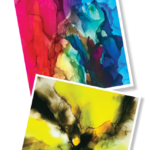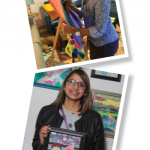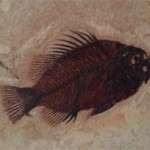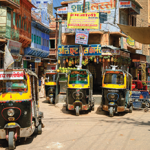Some artists paint with oils or watercolors, others with acrylics. Shivani Garg, MD, MS, prefers Nescafé or Maxwell House coffee.
A faculty member in the Division of Rheumatology in the Department of Medicine at the University of Wisconsin School of Medicine and Public Health (UWSMPH), Madison, Dr. Garg learned this technique—painting with instant coffee mixed with water—at summer art camp while living in India a decade ago.
“I worked with an artist at summer camp who used a lot of metallic paints and coffee,” she says. “With coffee, you can get a different shading effect. You can make it darker or dilute the medium to make it lighter. It gives nice colors and offers a nice gradation.”
Dr. Garg has been painting since she was 15 years old. She learned the art of painting from her mother, an architect, who paints as a hobby.
Since then, Dr. Garg has created 100 paintings. When living in India in 2011, she sold 22 paintings. This past October, 20 of her coffee paintings were on display for one month at UWSMPH. These paintings were also featured on her website along with her poetry.
She says practicing as a physician has helped her become more in tune with human emotions—not only her own but those of her patients—and better able to transfer those feelings onto canvas through various images and colors.
“Painting helps me process those emotions and better understand another person’s perspective,” she says. “It gives me an opportunity to release those emotions and also connect with patients.”
Academics & Accolades
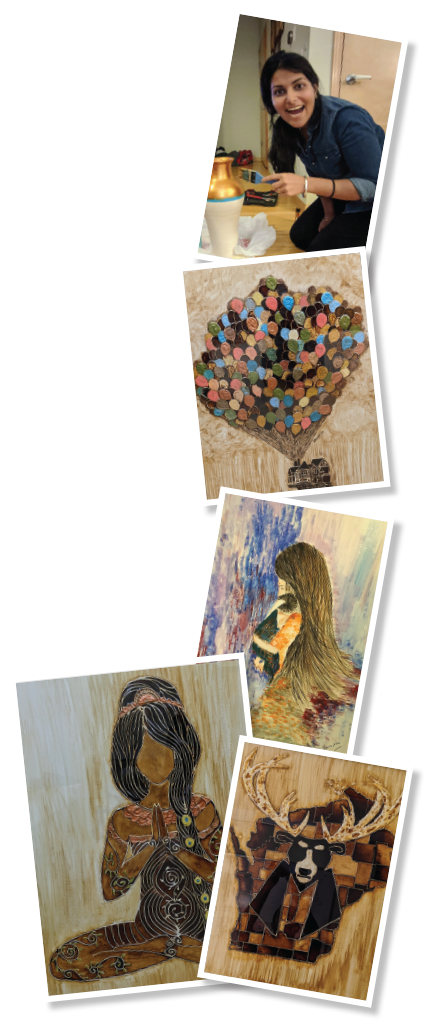
Dr. Garg decorates a pot.
Dr. Garg’s academic and medical career has been filled with accomplishments.
She graduated medical school in 2011 from the Government Medical College & Hospital, Chandigarh, India, receiving eight awards and achieving the highest rank in her class.
During the next three years, she completed her residency at Einstein Medical Center, Philadelphia. In 2017, she finished a rheumatology fellowship at Emory University, Atlanta. Also in 2017, she assumed her current role at UWSMPH, and the following year, earned a Master of Science in clinical investigation and research from UWSMPH.
Her clinical research is focused on better understanding the pathophysiology of lupus, improving outcomes and reducing disparities in lupus. She is developing interventions to improve adherence to pivotal therapies and examining early predictors of poor clinical outcomes, including cardiovascular disease and chronic kidney disease in patients with lupus and lupus nephritis.
In 2018, she set up a lupus clinic in Madison, Wis. That same year, she also established a multidisciplinary lupus nephritis clinic at UW Health, the academic medical center and health system for the University of Wisconsin, to provide comprehensive care to patients with lupus and lupus nephritis.
Over the past two years, she has presented at plenary sessions at ACR Convergence that addressed racial disparities in cardiovascular disease and stroke in patients with lupus.
Expressing Pain
Many of Dr. Garg’s paintings portray the pain her patients often experience.
“I try to imagine the feeling of what having pain is like and try to portray that in the form of art,” she says. “The colors I use, which can be light or dark, express the patient’s mood or expression of pain.”
What she really enjoys about painting with coffee is exploring potential differences in texture and color between various coffee products. Up to now, she has experimented with name brands, including Nescafé and Maxwell House, and several varieties of Indian coffee. However, she says there doesn’t appear to be any contrast between them.
Painting with coffee does offer a very unique benefit—the aroma.
“There’s a lot of aroma when you use it to paint,” she says, adding that a coffee painting must be framed in an air-tight picture frame to prevent the coffee paint from deteriorating. “In dry places, these paintings fare reasonably well. But in high-moisture places, there’s a high risk of damage that’s not reversible.”
Next, Dr. Garg is considering beets as a source of color because of their vibrant hues. The key to art, which she says is the visual connection between the internal and external worlds, is continuous learning from different artists, art communities, friends or colleagues who may have a good eye for design and can offer useful feedback. She also credits her husband for much of her inspiration, especially when she procrastinates. She says he’s always there, presenting her with a blank canvas and encouragement.
“I once tried to paint his portrait,” she says while laughing. “But it didn’t work out really well.”
Dr. Garg says painting is her form of meditation. It’s a release of feelings—positive or negative—that may be trapped inside her or people viewing her art.
“I hope people can look at my paintings and satisfy one of their expressions or emotions that they were not able to release,” she says. “Hopefully, at some point in their life, people can relate to them and be inspired by them.”
Carol Patton is a freelance writer based in Las Vegas.

